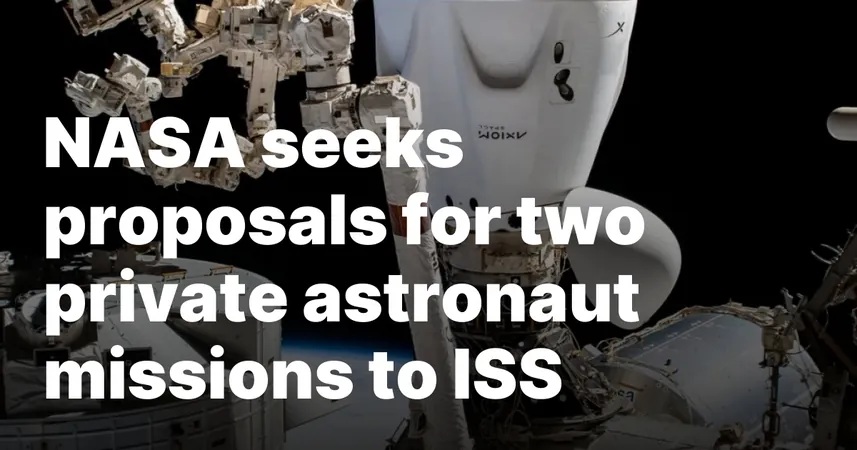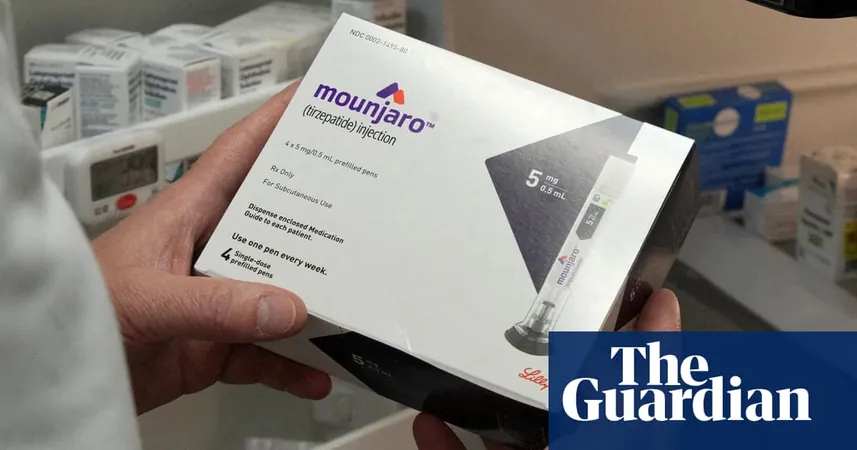
NASA Opens the Gates for Private Astronaut Missions to the ISS – Could Anyone Command Them?
2025-04-04
Author: Yu
NASA Opens the Gates for Private Astronaut Missions to the ISS – Could Anyone Command Them?
WASHINGTON – In a groundbreaking announcement, NASA is officially inviting proposals for two upcoming private astronaut missions (PAMs) to the International Space Station (ISS). This unique opportunity sparks excitement not just within the agency but across the entire aerospace industry, as it moves towards a future dominated by commercial space travel.
Originally announced on April 2, this solicitation seeks to explore the next phases of low Earth orbit commercialization. These two missions will be categorized as the fifth and sixth PAMs, part of a larger initiative aimed at transitioning from the ISS to one or more privately operated space stations. This strategic move highlights NASA’s ambition to leverage decades of space experience while empowering private companies to develop their own capabilities in the realm of space exploration.
“This is an exciting time for commercial spaceflight as we aim to train and manage crews, conduct research, and pave the way for future destinations in low Earth orbit,” stated Dana Weigel, NASA's ISS program manager. The PAMs are foundational in this effort, granting companies not only opportunities for collaboration but also the chance to refine their operational procedures and build invaluable partnerships essential for longevity in the aerospace sector.
New stipulations included in this solicitation represent a subtle but significant shift. Historically, each PAM was required to be commanded by a NASA veteran with prior flight experience. However, the latest call allows the potential for alternate commanders from international space agencies, broadening the pool of qualified professionals. Under these new guidelines, companies can suggest a commander with the same ISS operational requirements from the Canadian Space Agency, European Space Agency, or Japan Aerospace Exploration Agency.
This change could open doors for seasoned astronauts already involved in commercial ventures to take charge of these missions, diversifying the leadership pool. Among notable figures is former ESA astronaut Tim Peake, who joined Axiom Space’s team in July 2024 after the U.K. Space Agency explored a mission that would exclusively feature U.K. astronauts. Additionally, Axiom recruited Koichi Wakata, a former JAXA astronaut, as its astronaut and chief technical officer for the Asia-Pacific region in April 2024. Wakata expressed a keen interest in future flights, potentially embarking on missions with crews from the Asia-Pacific.
Axiom Space has emerged as a dominant player in the PAM landscape, earning contracts for all four previous missions to date. They successfully launched one mission each in 2022, 2023, and 2024. The next mission, Ax-4, is on schedule for launch no earlier than May.
However, the competitive environment is heating up. The company Vast, which aims to create its own commercial space stations, has publicly announced its plans to enter the PAM competition this time around, indicating a more competitive landscape for the upcoming proposals.
NASA maintains that it can accommodate up to two PAM missions each year, with PAM 5 targeted for no earlier than May 2026 and PAM 6 anticipated around mid-2027. The thrill of private exploration is on the horizon, but will Axiom Space maintain its lead, or will the emergence of new contenders shake up the industry? Stay tuned as we await further developments in this exciting chapter of space exploration!


 Brasil (PT)
Brasil (PT)
 Canada (EN)
Canada (EN)
 Chile (ES)
Chile (ES)
 Česko (CS)
Česko (CS)
 대한민국 (KO)
대한민국 (KO)
 España (ES)
España (ES)
 France (FR)
France (FR)
 Hong Kong (EN)
Hong Kong (EN)
 Italia (IT)
Italia (IT)
 日本 (JA)
日本 (JA)
 Magyarország (HU)
Magyarország (HU)
 Norge (NO)
Norge (NO)
 Polska (PL)
Polska (PL)
 Schweiz (DE)
Schweiz (DE)
 Singapore (EN)
Singapore (EN)
 Sverige (SV)
Sverige (SV)
 Suomi (FI)
Suomi (FI)
 Türkiye (TR)
Türkiye (TR)
 الإمارات العربية المتحدة (AR)
الإمارات العربية المتحدة (AR)